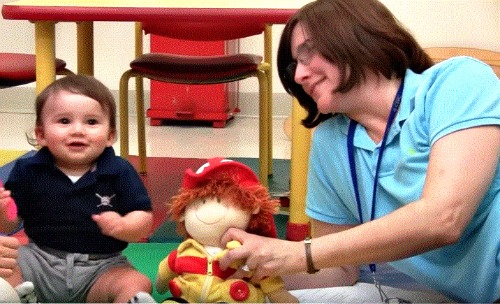
Watch as Dr. Lisa Shulman uses video of babies and toddlers to show the communication milestones expected in typically developing children.
When I was much younger and trying to decide what to do with my life, I thought I wanted to be a lawyer. That changed the day my high school civics class held a mock trial and I was selected as the “prosecutor.” Almost immediately, I discovered I didn’t have the makeup to be a lawyer. If you gave me a good argument on one side that I staunchly believed in, I was ready to make a case. But it didn’t take much to change my mind when I heard a good argument for the opposing point of view.
So I decided I wanted to pursue something more “black and white”—such as medicine. I reasoned that either you had strep throat or you didn’t. Either you had cancer, or congenital heart disease, or you didn’t. That was the paradigm that I was most comfortable with.
Making medical judgment calls
Fast-forward 25 years.
Given this early revelation about lawyering, how did I end up as an autism expert? Unlike doctors treating strep throat, confirmed by a throat culture, or heart disease, clearly evident on an echocardiogram, I decided to spend my days evaluating children for a condition that has no blood test, MRI finding or any other objective measure to help me make or dispel the diagnosis. Rather, it is based on a behavioral constellation—essentially, a judgment call about whether a child meets a behavioral definition.
Remember, I’m the wishy-washy one who changes opinions based on the strength of arguments offered by one side or the other. Today my life is filled with opinions. In working with children with developmental disabilities, I discovered that my passion for treating them was more important to me than the black-and-white thinking that I thought I preferred.
On any given day, there are children whom I evaluate who are clearly autistic. They can be diagnosed soon after they arrive in my office. Then there are children who are clearly not autistic. They may have another condition—language impairment, intellectual disability, attention deficit hyperactivity disorder, hearing impairment, an emotional problem—but not autism.
Many children fall into what I call the diagnostic “gray zone.” They may be quite young and have social weaknesses. But are they mildly autistic or just shy? Or they may be toddlers with irritable temperaments who eventually warm up after adjusting to being in my office for a couple of hours. Or a child may be a globally delayed toddler, who has a hearing or visual impairment and therefore experiences difficulty engaging with others.
You get the idea.
When parents testify about autism
Then factor in the parents’ opinions. There are some parents who walk in the door clearly having reviewed the behavioral criteria for autism spectrum disorders (ASD) before they left home. Others deny any autistic behavior in their children and attribute the multiple ASD symptoms that are clearly evident to the overwhelming number of toys I have in my office…or the poor sleep the children had the night before…or that the children are coming down with colds or the flu.
I often spend my days convincing parents who believe that their children have ASD that, thankfully, they don’t. Or trying to help parents who think their children are just shy or maybe a little behind in language development accept that they actually do have autism.
No one prays for an objective autism test—a gene or an MRI finding or other biomarker—more than I do. But in the meantime, I make use of behavioral instruments that help me organize my findings and communicate them to a highly experienced multidisciplinary team of colleagues, while reaching out to get feedback from parents, teachers and daycare providers. In other words, I use the tools available to help families navigate the various systems and therapeutic services to help children achieve the best outcome.
While my world might not be “black and white”—something I originally thought I wanted in my profession—I now accept the various shades of gray that are an inevitable, and everyday, part of my professional life.

